Ok. Some waiting. It’s tough to pinball your way around five European countries in two weeks without a little bit of butt-in-chair time. Then again, it allowed us to catch our breaths. We just got back and I’m still jetlagged. Longitude is a bitch. (I’m only now realizing that keto flu may also be involved. More on this in a future entry.)
But the trip, wow: It was something else.
We’d been planning this for a long time: a Christmas gathering of Carol’s close-in family in Europe, where our younger nephew Matt is working for a few years. Matt, his wife Justine, and their daughter live in Geneva, Switzerland, which is at the extreme southwestern corner of the country. Their townhome wouldn’t hold us all, so we pooled funds and rented a small ski chalet in Morzine, France, about an hour’s drive west. The chalet came with a caterer so that we could enjoy being together without worrying about where to buy food and how to cook it. All told, twelve adults and one little girl spent a week at the chalet.
For us, however, the chalet was the endpoint. To celebrate fifty years together, Carol and I took a week’s river cruise down the Rhine, from Amsterdam to Basel, Switzerland. We’d been wanting to do a river cruise for years, and there’s no better excuse than to celebrate half a century of being in love. Carol and I flew to Amsterdam via London Heathrow. We were joined by Carol’s sister Kathy and her husband Bob, and our older nephew Brian and his wife Alexis.
The cruise began in Amsterdam. The ship was the Amastella, from Ama Waterways. It’s 443 feet long and 38 feet wide. There were 140-odd people on the cruise. I never got a really good shot of the ship because it was so long; definitely follow the link to the company site for a photo. River cruise ship dimensions are constrained by the locks along the river. We traversed ten in a week, and the Amastella barely fit.
We passed a lot of quaint little towns, most of which had their names painted on the river levees, as shown with Filsen, below:

This part of the Rhine is castle country, and there were castles anywhere there were hilltops. Some were ruins. Some looked rebuilt or at least thoroughly repaired. Many were a mix of ruins and more modern construction. I pondered that I might possibly enjoy living in the one below—but would not enjoy the heating bills.
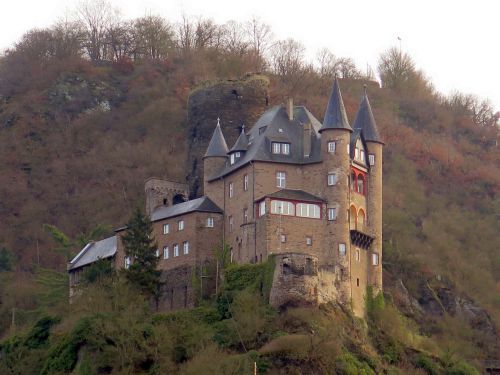
Every day there was a stop, and we typically toured the local cathedral and the many Christmas markets. We attended a wine tasting in a wine cave in Rudesheim, which was the first time I had ever been in a wine cave. The wine itself was marginal (I much prefer reds to whites) but at least I was able to put certain recent news items in perspective. (No thanks, Phil.)
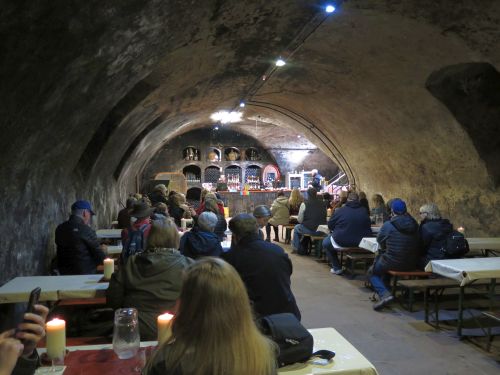
Also in Rudesheim was Siegfried’s Mechanical Instrument Museum. My pictures were not terrific, but Atlas Obscura has a very nice article on it, with excellent photos. Before conventional music recording, to have music people either had to play it themselves (or have other people play it) or have access to self-playing instruments. The player piano is the best known of these, and they were still being made circa 1960, when the family down the block from us bought one.
An orchestrion is just that: not merely a player piano, but a whole player orchestra. The museum has several, including one that has and plays six violins, all mechanically. It’s done with a revolving circular horsehair bow. The violins are tilted against the bow when played. Drums, chimes, and other instruments are often present, and the overall effect, given that it’s all stored as holes in rolls of paper, is uncanny.
The lighting in the museum was not the best, and the only reasonable photo I got was of the Weber Maesto, which was at heart a sort of player pipe organ. There’s a YouTube video of one in operation, and the quality of the music is startling.
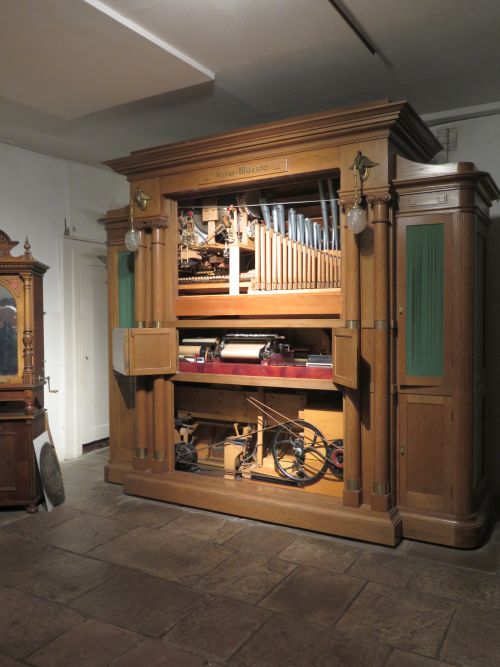
In Speyer was something I had not heard about until just before the trip and did not expect: The Speyer Technical Museum. Even now it defies description: They have machines of all sorts on display, with an emphasis on vehicles and aircraft. (They do have some boats and two submarines–and 25 sewing machines. I counted.) You can walk through the bigger submarine, although if you’re the least claustrophobic, don’t. Bogglingly, they have an entire 747 mounted at an odd angle literally 75 feet in the air, and you can climb down a ladder into its baggage compartment. Not boggled yet? Although the stairs up to the 747 can be arduous, if you have a nose for thrills you can slide back down to the ground in a (long) stainless-steel playground tube. (My nose for thrills is notoriously absent. I took the stairs both ways.)
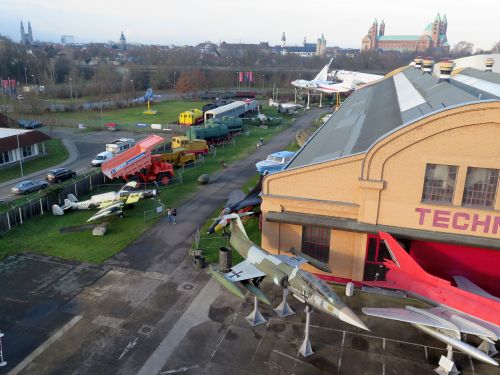
Above is an aerial view from the 747 platform. Inside is an incredible, jam-packed collection of damned near anything that moves. (Below.) Lotsa cars, planes, boats, trucks, locomotives, and military vehicles, including a halftrack motorcycle. Oh–and a merry-go-round.
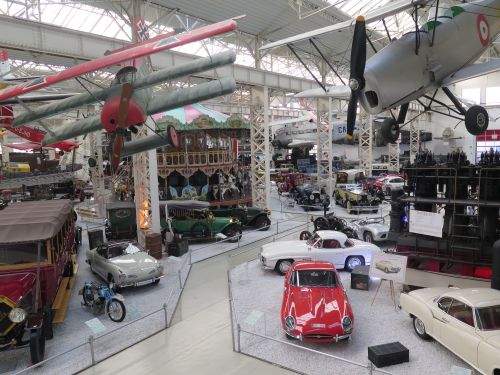
A couple of snapshots can’t do it justice. If you’re ever anywhere near Speyer, do not miss it–and plan to spend a couple of hours, minimum.
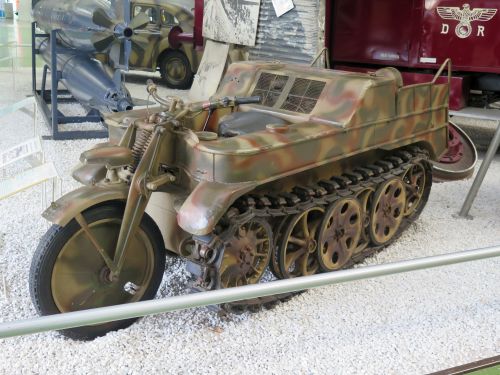
The architecture was an attraction no matter where we went. The building below (in Freiburg) is one of the coolest structures we saw. Alas, the tour guide told us what it is now (it may be an ex-rathaus) but I’ve forgotten.
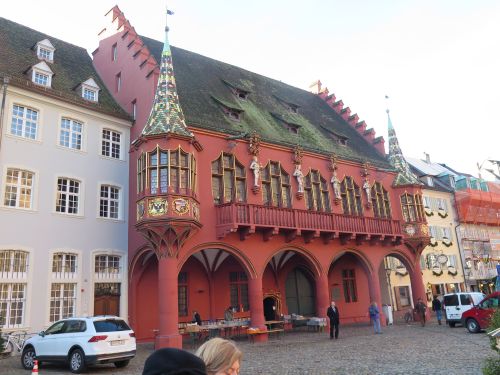
Among the cities we saw, Strasbourg (in France) was my personal favorite. Its cathedral is dazzling, especially its 3-story tall astronomical clock. I was unable to get decent pictures inside the Cathedral, but there’s an excellent article (with good photos) on Atlas Obscura. The clock shows planetary motions out to Saturn, phases of the Moon, sunrise and sunset times, and lots more, with all sorts of interesting mechanical gimmicks, including a mechanical rooster that crows, and a parade of the Apostles past the figure of Christ happening each day at solar noon in Strasbourg. And all this in a device built in 1843, with roots centuries before that.
I’ll get to the Christmas markets shortly, but in front of the Freiburg Cathedral there is a longstanding farmer’s market selling locally grown produce of all sorts, practically every day. Squash, carrots, bell peppers, leeks as long as my arm, and parsnips you could kill a man with:
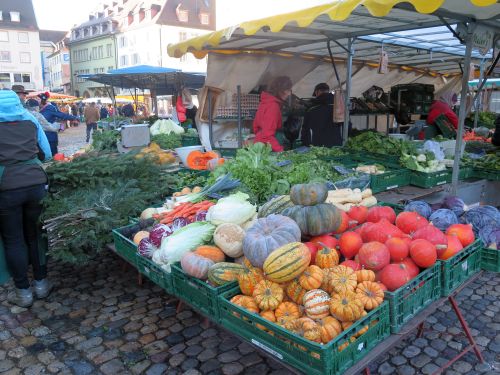
How all this produce survived to the end of December seems mysterious. I wonder how much can be had in late February? Greenhouses? If I’d known more German I would have asked.
I haven’t been in Europe a lot, and never over Christmas, so the Christmas market phenomenon took me a little by surprise. In virtually every town we visited, there was a Christmas market, and we saw most of them. It’s like nothing I’ve seen here: substantial booths selling Christmas food, ornaments, wine (especially gluhwein, which is warm mulled wine; white or red, your choice) jewelry, and handicrafts. German potato pancakes (kartoffelpuffers) and many kinds of sausages were everywhere.

The handicrafts were generally winter clothing, including a booth that takes the cake for the most socks I have ever seen in a single 15 foot expanse, ever:
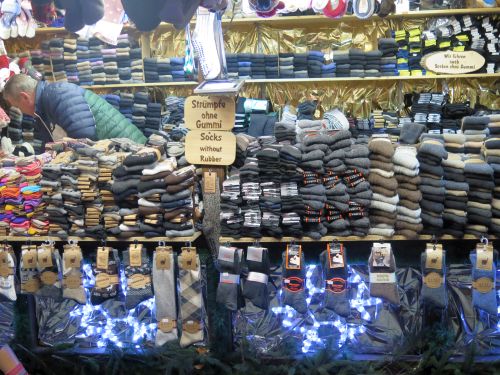
In the absense of an English translation of the little sign above, I might have thought they were selling gummi socks candy. But no: In German, “gummi” means “rubber,” and “Strumpfe ohne Gummi” means “socks without rubber.” I’m not sure why that’s a selling point, but he had two signs to make sure no one misunderstood.
We didn’t buy much. I had brought plenty of socks, and whatever we bought we’d have to drag home in our suitcases, which were already plenty heavy.
Frieburg was the last stop on the cruise, and the next day we docked at Basel, Switzerland, having visited Holland, Germany, and France. One final note: The food on the Amastella was superb, by far the best food on any cruise we’ve taken. The service was wonderful, the staterooms comfortable. I needn’t have worried about souvenirs; the three or four pounds I gained on the boat were more than enough.
And that’s where I’ll stop for today, given how long this entry has turned out to be. Next entry: Christmas with family…in the French Alps!











Wishing You and Carol good health, happiness, success and prosperity in the coming year!
““Strumpfe ohne Gummi” means “socks without rubber.” I’m not sure why that’s a selling point, but he had two signs to make sure no one misunderstood.”
Those socks belong to the same category as homeopathic “medicines” and organic food, biodynamic wine etc. . Anthroposophical stuff…
Interesting you should say that, as we passed Dornach on our way from Basel to Geneva, and Rudolf Steiner’s house was close to the tracks and clearly marked. Interesting man; I need to read his biography at some point.
[…] the saga with yesterday’s entry, if you haven’t read it already.) Once the river cruise boat saw us down the gangplank, the […]
I have socks with small pads of rubber on the soles, the rubber being an anti-skid mechanism if you wear the socks alone inside. They aren’t meant for use in shoes. Actualky, while I was in the hospital last year they issued me some of those socks when they started me back to walking.
“Silber Diabetikersocke ohne Gummi” = “Diabetic socks with soft top”
https://bestsilver.de/medical-silverwear/silver-socks/1/diabetic-socks-with-soft-top
Sounds like a wonderful trip! The Speyer Museum looks great. I also recommend the Deutsches Museum (both locations) in Munich (a whole floor dedicated to the history of computing). The German Christmas markets are great… I recommend the one in Nueremburg (the first one AFAIK). The ones in Munich, Stuttgart and Augsburg are also very good.